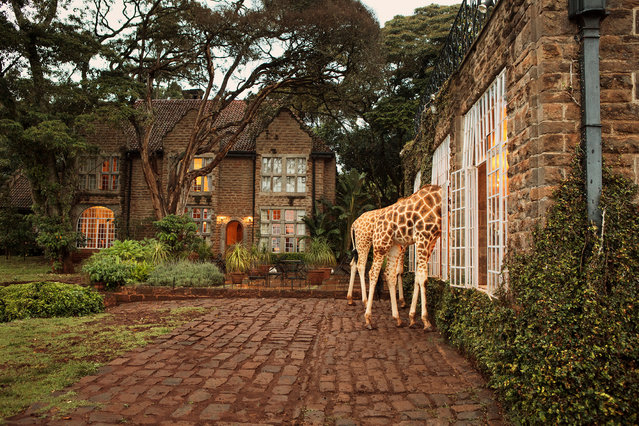
Situated 10km outside Nairobi city centre, this private giraffe sanctuary is centred around a colonial manor house named Giraffe Manor. Living within the grounds is a herd of rare Rothschild giraffe. (Photo by Klaus Thymann)

The herd has grown from the five that were originally brought there in 1974 as part of a conservation project. (Photo by Klaus Thymann)

The hotel, together with the associated Giraffe Centre next door, operates a breeding programme to reintroduce this species back into Kenya’s protected wild areas. Young calves born at the centre are generally introduced back into the wild at the age of two years. (Photo by Klaus Thymann)

At Giraffe Manor, the animals can wander round as they please. (Photo by Klaus Thymann)

The giraffes visit twice a day searching for food, before returning to the forest. Although still wild animals, they have become accustomed to receiving treats from residents and guests. (Photo by Klaus Thymann)

Set in 12 acres of private land within 140 acres of indigenous forest in the Karen suburb of Nairobi, the stately manor was originally erected as a home for Sir David Duncan in 1932. (Photo by Klaus Thymann)

Jock, an adolescent male, is one of the most inquisitive of the herd. (Photo by Klaus Thymann)

Toward the end of last year the 14-year-old giraffe, Kelly, gave birth to a baby boy. The as-yet unnamed newborn is Kelly’s third calf at the centre. (Photo by Klaus Thymann)

Giraffes give birth standing up, requiring the newborn to fall approximately two metres to the ground. But within the first hour a newborn can already stand up and run. (Photo by Klaus Thymann)

Kelly is named after the actress Grace Kelly, and in turn most of the giraffes themselves are named after individuals who have contributed to the charity African Fund for Endangered Wildlife (AFEW). (Photo by Klaus Thymann)

Rothschild giraffe are one of the most endangered giraffe subspecies, with only a few hundred left in the wild. There are more Rothschild giraffes kept in zoos than left in the wild. (Photo by Klaus Thymann)

For many years this subspecies was a favoured target for hunters in Kenya, eastern Uganda and southern Sudan. This considerably depleted their numbers and they were on the brink of extinction. (Photo by Klaus Thymann)

With the introduction of conservation projects, the giraffes have bounced back. (Photo by Klaus Thymann)
28 Jan 2016 12:36:00,
post received
0 comments
